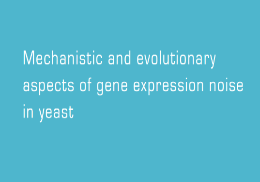Users
Social media
- More details here...
- Address
Parc Científic de la Universitat de València C/
Catedrático Agustín Escardino, 9
46980 Paterna (Valencia) Spain - Email:
iu.i2sysbio@uv.es - Phone:
(+34) 963544810
- Address
Links
Mechanistic and evolutionary aspects of noise in gene expression in yeast

Investigation & Education
Outreach
Mechanistic and evolutionary aspects of noise in gene expression in yeast

JOHN MCCARTHY. Date: April 14, 2016. Time: 12:30. Place: Sala d’Actes dels Instituts (Capçalera Building, Scientific Park, Universitat de València). Organized by: Institute of Integrative and Systems Biology I2SysBio (UV-CSIC). Presented by: Juli Pereto.
Abstract
The stochasticity (or noise) of gene expression is believed to be a critical source of non-genetic cellular diversity, from microbes to mammals, and to be involved in cellular decision making. By creating phenotypic diversity for cells that would otherwise be genetically identical, stochasticity is crucial for optimizing resource utilization and adaptation of microorganisms to a stressful fluctuating environment. In fact, it allows organisms to generate variants of subpopulations of cells that often have decreased fitness in their current environment, but can better adapt to environmental change. This phenomenon is known as diversified betting strategy (“bet-hedging”) and is widespread among microorganisms that manifest mechanisms such as bacterial persistence, sporulation and competition. Evolution as we understand it today could not have taken place without this noise. A recent analysis indicates that gene expression noise reduces average fitness in yeast by at least 25%. It is widely believed that the predominant source of this noise is transcription. However, in this talk I will demonstrate that this belief is a simplification. The yeast cell devotes a large percentage (>76%) of its “energy budget” to protein synthesis. Therefore, rate control and noise management in the translation machinery will have a major impact on the fitness of the organism. I am going to outline what we have learned about the “rules” that determine the relationship between mechanism, rate control and noise generation limits for components of the translation machinery.
About John McCarthy
Professor of Molecular Systems Biology and Director of the Warwick Integrative Synthetic Biology Center (WIBS) at the University of Warwick, UK United.
john.mccarthy@warwick.ac.uk
John MacCarthy studied Biochemistry at Oxford and began his research career studying the biochemistry and biophysics of electron transport-dependent ATP synthesis. In later years in Germany he switched to research on the mechanisms underlying the control and regulation of gene expression and became Head of Department at one of Germany's Federal Research Institutes. He also participated in several biotechnology challenges, collaborating with a large number of biotechnology and pharmaceutical companies. John moved to Manchester in 1996, where he was Head of the Department of Biomolecular Sciences at UMIST (1998-2000). He assumed leadership of the Manchester Interdisciplinary Biocentre project in 1998, and was Director of this institute from 2004 until 2010, when he became Head of Biological Sciences at the University of Warwick. John was awarded the Royal Society Wolfson Research Merit Award in 2002 and received a BBSRC Research Fellowship in 2007. John is currently Director of the BBSRC/EPSRC-funded Warwick Integrative Synthetic Biology Center (WISB). He has organized numerous scientific conferences and international postgraduate training courses, increasingly focusing on new interdisciplinary areas of research, and was one of the founding editors of the RSC Journal Biology Integrative. His current lines of research include the control of speed and noise in the eukaryotic gene expression pathway, and a series of synthetic biology projects.
Images:




